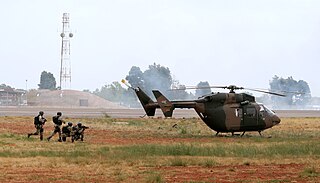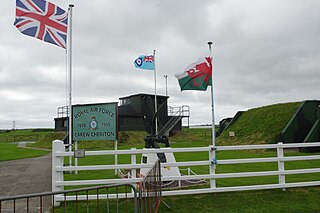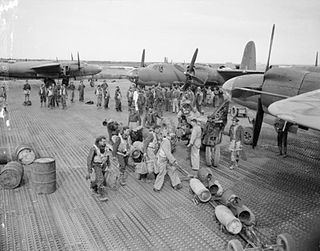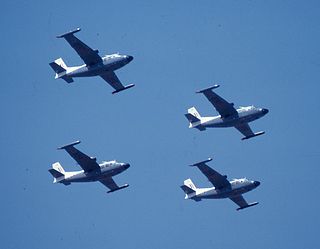
No. 206 Squadron is a Test and Evaluation Squadron of the Royal Air Force. Until 2005 it was employed in the maritime patrol role with the Nimrod MR.2 at RAF Kinloss, Moray. It was announced in December 2004 that 206 Squadron would disband on 1 April 2005, with half of its crews being redistributed to Nos. 120 and 201 Squadrons, also stationed at Kinloss. This was a part of the UK Defence Review called Delivering Security in a Changing World; the Nimrod MR.2 fleet was reduced in number from 21 to 16 as a consequence.

The Avro Anson is a British twin-engine, multi-role aircraft built by the aircraft manufacturer Avro. Large numbers of the type served in a variety of roles for the Royal Air Force (RAF), Fleet Air Arm (FAA), Royal Canadian Air Force (RCAF), Royal Australian Air Force and numerous other air forces before, during, and after the Second World War.

The Junkers Ju 86 was a German monoplane bomber and civilian airliner designed in the early 1930s, and employed by various air forces on both sides during World War II. The civilian model Ju 86B could carry ten passengers. Two were delivered to Swissair and five to Deutsche Luft Hansa. In addition a single civilian Ju 86Z was delivered to Sweden's AB Aerotransport.

15 Squadron SAAF is a squadron of the South African Air Force. It is currently a transport/utility helicopter squadron.

22 Squadron is a squadron of the South African Air Force. It is currently a maritime helicopter squadron operating Lynx and Oryx helicopters for the South African Navy. Originally formed in 1942, the squadron is the only current maritime helicopter squadron of the SAAF. It has been involved with many rescues, some gaining international attention as well as arctic base support.
Royal Air Force Bircham Newton or more simply RAF Bircham Newton is a former Royal Air Force station located 2.1 miles (3.4 km) south east of Docking, Norfolk and 13.4 miles (21.6 km) north east of King's Lynn, Norfolk, England.

No. 500 Squadron AAF was a Royal Air Force flying squadron. It was initially formed in 1931 as a Special Reserve squadron and in 1936 became part of the Auxiliary Air Force, at this time based at Manston and Detling.
No. 204 Squadron was a Royal Air Force unit first formed in March 1915 as No.4 Squadron Royal Naval Air Service.

Royal Air Force Carew Cheriton, or more simply RAF Carew Cheriton, is a former Royal Air Force station located near Carew, Pembrokeshire. It was situated 4.7 miles (7.6 km) north west of Tenby.
No. 608 Squadron was an Auxiliary Air Force squadron of the Royal Air Force during the Second World War. It flew during its existence as a bomber, fighter and reconnaissance unit and was the only RAF squadron to be equipped with the unsuccessful Blackburn Botha torpedo bomber.

3 Squadron SAAF was a squadron of the South African Air Force. It was formed in January 1939 at Air Force Base Waterkloof and was equipped with Hawker Hartbees I and Hurricane Mk II aircraft. The squadron was moved to Port Elizabeth in September 1939 after which it was disbanded. It was again reformed at Waterkloof on 9 September 1940 equipped with Hurricane Mk 1s.

6 Squadron was a South African Air Force unit first formed just before World War II. It was disbanded and re-created a number of times, until finally disbanded in October 1990.

12 Squadron was a South African Air Force squadron that served in the Second World War in East Africa and the Western Desert as a medium bomber squadron. After the war, the squadron was used in various roles, including that of a helicopter squadron until 1963, when it was equipped with English Electric Canberra light bombers, remaining a light bomber and reconnaissance squadron until disbanded in 1990.

10 Squadron was a squadron of the South African Air Force. It was formed as a fighter bomber unit on 1 April 1939 and was deployed in a coastal defence role as part of Coastal Command SAAF until 1943. It was disbanded after the threat of Japanese naval actions off the South African coast had waned. It was re-activated as a fighter squadron on 25 May 1944 and deployed to the Middle East where the squadron saw service in Syria, Libya and the Aegean and was disbanded at the end of the war in Italy.

25 Squadron was a maritime patrol and later medium bomber squadron of the South African Air Force during World War II. It was re-constituted twice between 1951 and 1990 as a medium transport squadron and was finally disbanded in October 1990.

29 Squadron was one of the Coastal Command SAAF of the South African Air Force during the Second World War. It was assigned the role of maritime patrol and shipping escort and operated Venturas from Lombazi on the Pondoland coast. With the decline in activities in the war at sea, the squadron was disbanded on 15 November 1943 and absorbed into 29 Operational Training Unit based at Darling in the Cape. The squadron was re-activated in August 1944 and deployed to Matubatuba in Zululand from where it once again operated with Venturas. At this time, the squadron did very little flying and was disbanded at the end of the war.

27 Squadron was established as a World War II maritime patrol squadron of the South African Air Force. It was disbanded after the war and resurrected in the same role from 1951 to 1958. Its final period of service was from 1962 to 1990 when it was finally disbanded when its Piaggio Albatross aircraft were de-commissioned.

31 Squadron was initially a World War II Coastal bomber/reconnaissance squadron South African Air Force. It was later converted to a heavy bomber squadron that operated from bases in the Mediterranean from January 1944 until the end of the war. On conclusion of hostilities, the squadron was used to ferry liberated POW's from Italy back to Britain and disbanded South African troops from Italy to Egypt. It was disbanded on 15 December 1945. It was resurrected as a medium and light helicopter squadron in 1982 and operated from AFB Hoedspruit until its final disbandment on 4 December 1992.
The History of the South African Air Force spans the First World War, Rand Rebellion of 1922, the Second World War, the Korean War, the South African Border War, and varied peacekeeping operations since 1994. Its battle honours include German South West Africa 1914–15, German East Africa 1915–1918, East Africa: 1939–1941, Middle East: 1941–43, Madagascar 1942, Italy 1943–1945, the Balkans 1943–1945, and Korea 1950–1953.
Southern Air Command was a formation of the South African Air Force, active from the early 1980s to the early 1990s. Throughout its existence, it had its headquarters at Silvermine, in the Cape Province.


















